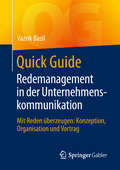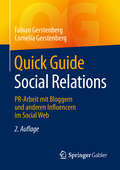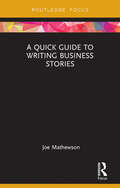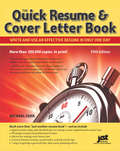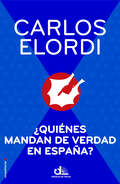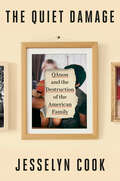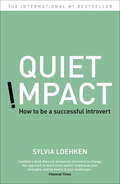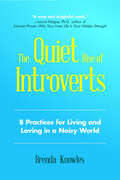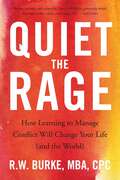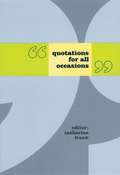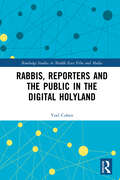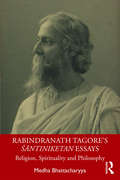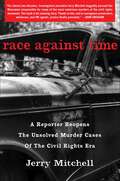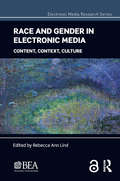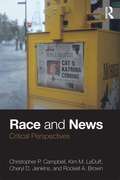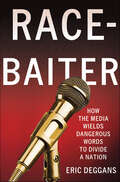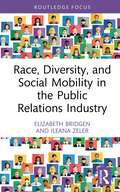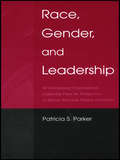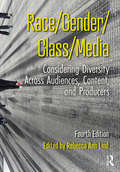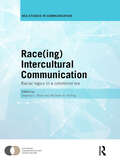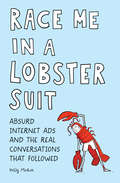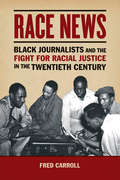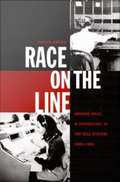- Table View
- List View
Quick Guide Redemanagement in der Unternehmenskommunikation: Mit Reden überzeugen: Konzeption, Organisation und Vortrag (Quick Guide)
by Vazrik BazilDieses Buch richtet sich an alle, die ihrem Unternehmen oder ihrer Organisation zu einem erfolgreichen Auftritt verhelfen wollen, sei es als Redner, Redenschreiber oder Kommunikationsverantwortlicher. Es zeigt kurz und kompakt auf, wie ein gelungenes Redemanagement zentrale Knotenpunkte – Konzeption, Niederschrift, Vortrag und Organisation der Redeproduktion – optimal miteinander verknüpft. Der Autor erklärt die Grundlagen eines erfolgreichen Redemanagements, mit deren Hilfe die Rede als wirkungsvolles Kommunikationsinstrument eingesetzt werden kann: von der Idee über die Anordnung der Inhalte und die konkreten Formulierungen bis hin zu Gedächtnisübungen und dem eigentlichen Auftritt. Erstmalig erläutert der Autor auch die Funktionsweise von Crowd-Ghostwriting, eine von ihm erfundene Methode der Redeproduktion. Zudem regt er wertvolle Übungen an und gibt inspirierende Denkanstöße für Ihre Redepraxis.
Quick Guide Social Relations: PR-Arbeit mit Bloggern und anderen Influencern im Social Web (Quick Guide)
by Fabian Gerstenberg Cornelia GerstenbergDieses Buch zeigt, wie PR-Schaffende erfolgreich mit Bloggern und anderen einflussreichen Akteuren des Social Webs interagieren können. Die Autoren bieten in diesem Quick Guide einen schnellen und direkt anwendbaren Zugang zu den neuen Kommunikationsregeln im Internet, konkrete Handlungsempfehlungen für Blogger Relations und zielgerichtete Impulse, um die Öffentlichkeitsarbeit mit reichweitenstarken Multiplikatoren und Influencern im Netz professionell zu optimieren. Außerdem: Erfolgreiche Blogger geben Branchen-Insights und erklären, wie man gut mit ihnen ins Gespräch kommt.Neu in der aktualisierten 2. Auflage: Zahlreiche Transferübungen für die direkte Anwendung in der Praxis.
A Quick Guide to Writing Business Stories
by Joe MathewsonBusiness journalism is of critical importance to society, though it may appear to some that it concerns only big business and big investors. A Quick Guide to Writing Business Stories helps students acquire the marketable writing skills required to succeed in this competitive and vibrant segment of print and online journalism. This hands-on, practical text provides step-by-step guidance on how to write business articles such as the corporate quarterly earnings story, small business profiles, and business or consumer trend stories. Mathewson’s book, based on Northwestern University’s highly successful business journalism program, guides students in the use of data, documents and sophisticated expert sources. With A Quick Guide to Writing Business Stories as their resource, students will be able to write challenging stories with clarity and speed, greatly enhancing the journalist’s ability to tackle stories on other complex topics, in any medium.
The Quick Resume & Cover Letter Book
by Michael FarrTeaches job seekers how to master essential steps in the job search process. As the definitive guide to resumes, it offers techniques proven to get results quickly; a friendly, easy-to-follow design; and rock-solid advice for creating outstanding resumes and cover letters and, more importantly, using them effectively.
¿Quiénes mandan de verdad en España?
by Carlos Elordi«¿Quiénes mandan de verdad en España?» es la pregunta a la que el reputado periodista Carlos Elordi pretende dar respuesta con claridad meridiana en este libro. Las elecciones celebradas cada cuatro años en España solo dan el pistoletazo de salida para que los poderes fácticos que de verdad rigen los designios del país se posicionen para dirigir el futuro de la nación. La banca, los grandes empresarios, la Iglesia católica, la Casa Real, la Unión Europea..., influyen en la toma de decisiones y cada uno de ellos ejerce directamente presión sobre la sociedad.Elordi analiza en este libro cómo se articulan internamente esos poderes, cómo ha evolucionado la capacidad de influencia de unos y otros sectores y cuáles la han ganado o la han perdido como consecuencia de la actual crisis económica. Un análisis que se completa con un repaso a la estructura del poder en algunas regiones y un capítulo específico se destina a los medios de comunicación. Un ensayo que arroja luz sobre este imbricado mosaico que es el poder en España.
The Quiet Damage: QAnon and the Destruction of the American Family
by Jesselyn CookThe &“gripping&” (The Atlantic) story of five families shattered by pernicious, pervasive conspiracy theories, and how we might set ourselves free from a crisis that could haunt American life for generations.&“Excellent . . . This is the intimate side of the cold civil war America has been stuck in for nearly a decade.&”—Michelle Goldberg, The New York Times &“SHED MY DNA&”: three excruciating words uttered by a QAnon-obsessed mother, once a highly respected lawyer, to her only son, once the closest person in her life. QAnon beliefs and adjacent conspiracy theories have had devastating political consequences as they&’ve exploded in popularity. What&’s often overlooked is the lasting havoc they wreak on our society at its most basic and intimate level—the family. In The Quiet Damage, celebrated reporter Jesselyn Cook paints a harrowing portrait of the vulnerabilities that have left so many of us susceptible to outrageous falsehoods promising order, purpose, and control. Braided throughout are the stories of five American families: an elderly couple whose fifty-year romance takes a heartbreaking turn; millennial sisters of color who grew up in dire poverty—one to become a BLM activist, the other, a hardcore conspiracy theorist pulling her little boy down the rabbit hole with her; a Bay Area hippie-type and her business-executive fiancé, who must decide whether to stay with her as she turns into a stranger before his eyes; evangelical parents whose simple life in a sleepy suburb spirals into delusion-fueled chaos; and a rural mother-son duo who, after carrying each other through unspeakable tragedy, stop speaking at all as ludicrous untruths shatter a bond long thought unbreakable.Charting the arc of each believer&’s path from their first intersection with conspiracy theories to the depths of their cultish conviction, to—in some cases—their rejection of disinformation and the mending of fractured relationships, Cook offers a rare, intimate look into the psychology of how and why ordinary people come to believe the unbelievable. Profound, brilliantly researched, and beautifully written, The Quiet Damage lays bare how we have been taken hostage by grifters peddling lies built on false hope—and how we might release our loved ones, and ourselves, from their grasp.
Quiet Impact: How to be a successful Introvert
by Sylvia LoehkenMost literature on business, communication and success is focused on extroverts, who feel comfortable networking, talking and being the centre of attention. But at least 30% of the population are introverts, and they are now finding their voice. Quiet Impact - How to Be a Successful Introvert is already an international phenomenon. Using the latest psychological research, and Dr Loehken's own extensive experience coaching introverts in the workplace, it is packed with practical advice which is easy to implement. Dr Loehken identifies 10 strengths specific strengths that introverts often have (such as independence, perseverance and writing), and also identifies ten specific hurdles they often have to overcome (such as hyperstimulation, intellectualism and fear of conflict).
Quiet Impact: How to be a successful Introvert
by Sylvia LoehkenMost literature on business, communication and success is focused on extroverts, who feel comfortable networking, talking and being the centre of attention. But at least 30% of the population are introverts, and they are now finding their voice.Quiet Impact - How to Be a Successful Introvert is already an international phenomenon. Using the latest psychological research, and Dr Loehken's own extensive experience coaching introverts in the workplace, it is packed with practical advice which is easy to implement.Dr Loehken identifies 10 strengths specific strengths that introverts often have (such as independence, perseverance and writing), and also identifies ten specific hurdles they often have to overcome (such as hyperstimulation, intellectualism and fear of conflict).
The Quiet Rise of Introverts: 8 Practices for Living and Loving in a Noisy World
by Brenda KnowlesIntroverts Loving and Living“Brilliant and a must read for introverts and extroverts alike who have a desire to strengthen their relationship!” —Bill Zajac, author UNBEATABLE MARRIAGE#1 New Release in Emotional Self-HelpMore and more, people are identifying as introverts. There are many facets to being an introvert and many variations to each type. But as you peel back the layers to all these types you quickly learn that introverts make up 50% of the world’s population. And, studies show that at least one-third of the people we encounter in our lives are introverts. The Quiet Rise of Introverts: 8 Practices for Loving and Living in a Noisy World is a guide to help tenderhearted and introverted individuals grow and nurture their peace, purpose, and relationships.Introverts and sensitivity. Author, speaker and life coach Brenda Knowles presents 8 unique practices to help readers learn that they are not alone or flawed in their sensitivity and introversion. Certified as a Myers-Briggs practitioner, she has been writing and guiding introverts for many years in space2live and has provided training as a family mediator.The intention of this book is not to turn introverts into extroverts. The 8 practices in this book serve as action steps to help you move past the anxiety and stress of living an ill-fitting extroverted life to the secure and fulfilling state of authenticity and deep connection with others.Read The Quiet Rise of Introverts and find:A calmer sense of selfA deeper understanding of mental and physical self-careAn embracing of positive conflictGrowth in responsivenessThe secret to healing every dayIf you likes books such as Susan Cain’s Quiet: The Power of Introverts in a World That Can’t Stop Talking, The Introvert’s Way, or Amy Cuddy’s Presence, then you will love The Quiet Rise of Introverts by Brenda Knowles.
Quiet the Rage: How Learning to Manage Conflict Will Change Your Life (and the World)
by R.W. BurkeIn a world with more than 7 billion people, 196 countries, 7,000 spoken languages, and close to 30 religions, the probability of one group or one person intentionally or unintentionally offending another group or another person is absolutely certain. Many people limit themselves in life based on their inability to get along with others, and too often we allow ourselves to be ruled by our emotions. When we&’re emotionally reactive, we&’re not our best selves, nor do we produce the smartest outcomes. Emotional reactions create winners and losers. And winning directly at the expense of another is actually losing in disguise, due to the resentment it inspires in the loser. Often, people get stuck in a pattern of reacting emotionally, long past the time when the combativeness that once served them no longer does; long past the time when the pattern has become destructive without them being aware of it. For everyone who wants to change that part of themselves—everyone who wants more peaceful interactions and more successful outcomes, but doesn&’t know how to achieve that—Quiet the Rage is the answer.
Quotations for All Occasions
by Catherine FrankOn the most important occasions of our lives, we often find ourselves at a loss for words; when we want to console, celebrate, explain, inspire, or thank, we end up repeating such uninspiring, uninformative phrases as "Words cannot express how I feel." To help us find the right words, Catherine Frank has compiled this handy compendium of quotations that capture the mundane and the magnificent, the everyday and extraordinary moments of our lives.The three sections of the book cover 150 occasions. "Every Year" offers quotations on all the special dates in the calendar from New Year's Day to New Year's Eve, including Martin Luther King Day, Valentine's Day, Ramadan, Mother's Day, Thanksgiving, Kwanzaa, and Christmas. "Occasionally" presents quotations on such occasions as giving a speech, having an interview, becoming a parent, getting engaged, welcoming someone, and saying goodbye. "Once in a Lifetime" provides quotations on such momentous events as confirmation, coming out, turning 16, graduation, and retirement. A sampling: Plato, John Donne, and Woody Allen give their words of wisdom on death. Betty Ford writes eloquently on recovery. Martina Navratilova ruminates on her first sexual encounter... and Holden Caufield on his. Ralph Waldo Emerson, Mark Twain, and Frederick Douglass ponder Independence Day. Amy Tan reflects on the meaning of the Chinese New Year. Samuel Taylor Coleridge and Susan Sontag offer poignant descriptions of pain and illness.Whether you are offering consolation or congratulations, condolences or confessions, Quotations for All Occasions has the perfect words for every occasion.
Rabbis, Reporters and the Public in the Digital Holyland (Routledge Studies in Middle East Film and Media)
by Yoel CohenFocused on the triangular relationship between rabbis, journalists and the public, this book analyses each group’s role in influencing the agenda around religion in Israel. The book draws upon the author's original research, comprising an analysis of the coverage of religion on four Israeli news websites, a series of surveys of rabbis, journalists, and the public, as well as a large number of interviews conducted with a range of stakeholders: community rabbis, teacher rabbis, and religious court judges; reporters, editors, and spokespersons; and the Israeli Jewish public. Key questions include: What are rabbis’ philosophical views of the media? How does the media define news about Judaism? What aspect of news about religion and spirituality interest the public? How do spokespersons and rabbis influence the news agenda? How is the triangular relationship between rabbis, journalists and the public being altered by the digital age? Despite a lack of understanding about mass media behaviour among many rabbis, and, concurrently, a lack of knowledge about religion among many journalists, it is argued that there is shared interest between the two groups, both in support of mass-media values like the right to know and freedom of expression. It is further argued that the public's attitude to news about religion is significant in determining what journalists should publish. The book will be of interest to those studying mass communications, the media, Judaism and Israeli society, as well as researchers of media and religion.
Rabbis, Reporters and the Public in the Digital Holyland (Routledge Studies in Middle East Film and Media)
by Yoel CohenFocused on the triangular relationship between rabbis, journalists and the public, this book analyses each group’s role in influencing the agenda around religion in Israel.The book draws upon the author's original research, comprising an analysis of the coverage of religion on four Israeli news websites, a series of surveys of rabbis, journalists, and the public, as well as a large number of interviews conducted with a range of stakeholders: community rabbis, teacher rabbis, and religious court judges; reporters, editors, and spokespersons; and the Israeli Jewish public. Key questions include: What are rabbis’ philosophical views of the media? How does the media define news about Judaism? What aspect of news about religion and spirituality interest the public? How do spokespersons and rabbis influence the news agenda? How is the triangular relationship between rabbis, journalists and the public being altered by the digital age? Despite a lack of understanding about mass media behaviour among many rabbis, and, concurrently, a lack of knowledge about religion among many journalists, it is argued that there is shared interest between the two groups, both in support of mass-media values like the right to know and freedom of expression. It is further argued that the public's attitude to news about religion is significant in determining what journalists should publish.The book will be of interest to those studying mass communications, the media, Judaism and Israeli society, as well as researchers of media and religion.
Rabindranath Tagore's Śāntiniketan Essays: Religion, Spirituality and Philosophy
by Medha BhattacharyyaThis book provides a critical introduction and translation of fifty Śāntiniketan (Abode of Peace) essays written by Rabindranath Tagore between 1908 and 1914. It provides key insights into Tagore’s fundamental meditations on life, nature, religion, philosophy and the world at large. As the first of its kind, this volume is a definitive collection of Tagore’s Śāntiniketan essays translated into English which contains a substantial amount of scholarly material on them. The essays look at Tagore’s ideas of universality, his socio-cultural location along with the development of his thought, his reflections on Buddhism, Vaiṣṇavism, Bāul philosophy, the Bhagavadgītā and to a great extent the Upanishads and their contemporary relevance. It also connects Sri Ramakrishna’s concepts of vijnāna and bhāvamukha with Tagore’s thought, an original contribution, through the study of these essays. A nuanced exploration into translation theory and praxis, it fills a lacuna in Tagore Studies by bringing to the fore profound religious, spiritual and philosophical knowledge in Tagore’s own voice. This volume will be useful for scholars and researchers of Translation Studies, Tagore Studies, Language and Literature, Cultural Studies and readers interested in Tagore’s philosophical ideas.
Race Against Time: A Reporter Reopens the Unsolved Murder Cases of the Civil Rights Era
by Jerry Mitchell&“For almost two decades, investigative journalist Jerry Mitchell doggedly pursued the Klansmen responsible for some of the most notorious murders of the civil rights movement. This book is his amazing story. Thanks to him, and to courageous prosecutors, witnesses, and FBI agents, justice finally prevailed.&” —John Grisham, author of The GuardiansOn June 21, 1964, more than twenty Klansmen murdered three civil rights workers. The killings, in what would become known as the &“Mississippi Burning&” case, were among the most brazen acts of violence during the Civil Rights Movement. And even though the killers&’ identities, including the sheriff&’s deputy, were an open secret, no one was charged with murder in the months and years that followed. It took forty-one years before the mastermind was brought to trial and finally convicted for the three innocent lives he took. If there is one man who helped pave the way for justice, it is investigative reporter Jerry Mitchell. In Race Against Time, Mitchell takes readers on the twisting, pulse-racing road that led to the reopening of four of the most infamous killings from the days of the Civil Rights Movement, decades after the fact. His work played a central role in bringing killers to justice for the assassination of Medgar Evers, the firebombing of Vernon Dahmer, the 16th Street Church bombing in Birmingham and the Mississippi Burning case. Mitchell reveals how he unearthed secret documents, found long-lost suspects and witnesses, building up evidence strong enough to take on the Klan. He takes us into every harrowing scene along the way, as when Mitchell goes into the lion&’s den, meeting one-on-one with the very murderers he is seeking to catch. His efforts have put four leading Klansmen behind bars, years after they thought they had gotten away with murder. Race Against Time is an astonishing, courageous story capturing a historic race for justice, as the past is uncovered, clue by clue, and long-ignored evils are brought into the light. This is a landmark book and essential reading for all Americans.
Race and Gender in Electronic Media: Content, Context, Culture (Electronic Media Research Series)
by Rebecca Ann LindThis volume examines the consequences, implications, and opportunities associated with issues of diversity in the electronic media. With a focus on race and gender, the chapters represent diverse approaches, including social scientific, humanistic, critical, and rhetorical. The contributors consider race and gender issues in both historical and contemporary electronic media, and their work is presented in three sections: content, context (audiences, effects, and reception), and culture (media industries, policy, and production). In this book, the authors investigate, problematize, and theorize a variety of concerns which at their core relate to issues of difference. How do we use media to construct and understand different social groups? How do the media represent and affect our engagement with and responses to different social groups? How can we understand these processes and the environment within which they occur? Although this book focuses on the differences associated with race and gender, the questions raised by and the theoretical perspectives presented in the chapters are applicable to other forms of socially-constructed difference. Chapters 5, 10, 12, and 19 of this book are freely available as downloadable Open Access PDFs at http://www.taylorfrancis.com under a Creative Commons Attribution-Non Commercial-No Derivatives (CC-BY-NC-ND) 4.0 license.
Race and News: Critical Perspectives
by Christopher P. Campbell Rockell A. Brown Cheryl D. Jenkins Kim M. LeDuffThe history of American journalism is marked by disturbing representations of people and communities of color, from the disgraceful stereotypes of pre-civil rights America, to the more subtle myths that are reflected in routine coverage by journalists all over the country. Race and News: Critical Perspectives aims to examine these journalistic representations of race, and in doing so to question whether or not we are living in a post-racial world. By looking at national coverage of stories like the Don Imus controversy, Hurricane Katrina, Barak Obama's presidential candidacy, and even the Virginia Tech shootings, readers are given an opportunity to gain insight into both subtle and overt forms of racism in the newsroom and in national dialogue. The book itself is divided into two sections, with the first examining the journalistic routine and the decisions that go into covering a story with, or without, relation to race. The second section, comprised of case studies, explores the coverage of national stories and how they have impacted the dialogue on race and racism in the United States. As a whole, the collection of essays and studies also reflects a variety of research approaches. With a goal of contributing to the discussion about race and its place in American journalism, this broad examination makes Race and News an ideal text for courses on cultural diversity and the media, as well as making it valuable to professional journalists and journalism students who seek to improve their approach to coverage of diverse communities.
Race-Baiter: How the Media Wields Dangerous Words to Divide a Nation
by Eric DeggansGone is the era of Edward R. Murrow and Walter Cronkite, when news programs fought to gain the trust and respect of a wide spectrum of American viewers. Today, the fastest-growing news programs and media platforms are fighting hard for increasingly narrow segments of the public and playing on old prejudices and deep-rooted fears, coloring the conversation in the blogosphere and the cable news chatter to distract from the true issues at stake. Using the same tactics once used to mobilize political parties and committed voters, they send their fans coded messages and demonize opposing groups, in the process securing valuable audience share and website traffic. Race-baiter is a term born out of this tumultuous climate, coined by the conservative media to describe a person who uses racial tensions to arouse the passion and ire of a particular demographic. Even as the election of the first black president forces us all to reevaluate how we think about race, gender, culture, and class lines, some areas of modern media are working hard to push the same old buttons of conflict and division for new purposes. In Race-Baiter, veteran journalist and media critic Eric Deggans dissects the powerful ways modern media feeds fears, prejudices, and hate, while also tracing the history of the word and its consequences, intended or otherwise.
Race, Diversity, and Social Mobility in the Public Relations Industry (Global PR Insights)
by Elizabeth Bridgen Ileana ZelerThis book explores the recent academic and practice‑based research and thinking on race, diversity, and social mobility within the public relations industry, arguing for the necessity of more transformative actions to address systemic inequities.Through an analysis of interviews with UK‑based public relations practitioners from a wide range of backgrounds, this book integrates and illustrates different strands of research to shed light on persistent challenges and opportunities in the field and understand how those who are often the subjects of such discussions experience discrimination. The authors introduce complex topics in an accessible manner, providing an overview of recent research, demonstrating practical applications of theoretical frameworks, and suggesting reading for further exploration. It also includes additional pedagogical features which allow readers to explore specific topics through guided reading and exploratory questions.By grounding its analysis in the lived experiences of public relations practitioners, this book contributes to the literature of race, diversity, and social mobility while fostering discussion on the systematic discrimination faced by practitioners. It will help and encourage researchers, educators, and practitioners to critically explore their own practice and open up new conversations about this crucial issue.
Race, Gender, and Leadership: Re-envisioning Organizational Leadership From the Perspectives of African American Women Executives (Routledge Communication Series)
by Patricia S. ParkerMuch has been written about a model of leadership that emphasizes women's values and experiences, that is in some ways distinct from male models of leadership. This book redirects the focus to a view of leadership as a multicultural phenomenon that moves beyond dualistic notions of "masculine" and "feminine" leadership, and focuses more specifically on leadership as the management of meaning, including the meanings of the notion of "organizational leader." This volume focuses on leadership "traditions" revealed in the history of Black women in America and exemplified in the leadership approaches of 15 African American women executives who came of age during the civil rights and feminist movements of the 1960's and 1970's and climbed to the top of major U.S. organizations. It advances a vision of organizational leadership that challenges traditional masculine and feminine notions of leadership development and practice, providing insights on organizational leadership in the era of post-industrialization and globalization. Additionally, by placing African American women at the center of analysis, this book provides insights into the ways in which race and gender structure key leadership processes in today's diverse and changing workplace. It is a must-read for scholars and researchers in organizational communication, management, leadership, African American studies, and related areas.
Race/Gender/Class/Media: Considering Diversity Across Audiences, Content, and Producers
by Rebecca Ann LindRace/Gender/Class/Media considers diversity in the mass media in three main settings: Audiences, Content, and Production. It brings together 53 readings—most are newly commissioned for this edition—by scholars representing a variety of social science and humanities disciplines. Together, these readings provide a multifaceted and often intersectional look at how race, gender, and class relate to the creation and use of media texts as well as the media texts themselves. Designed to be flexible in the classroom, the book begins with a detailed introduction to key concepts and presents a contextualizing introduction to each of the three main sections. Each reading contains multiple It’s Your Turn activities to foster student engagement and which can serve as the basis for assignments. The book offers a list of resources—books, articles, films, and websites—that are of value to students and instructors. Several alternate Tables of Contents are provided as options for reorganizing the material and maximizing the flexibility of the readings: by site of struggle (gender, race, class), by medium (television, print, digital, etc.), and by arena (journalism, entertainment). This volume is an essential introduction to interdisciplinary studies of gender, race, and class across mass media.
Race(ing) Intercultural Communication: Racial Logics in a Colorblind Era
by Dreama G. Moon and Michelle A. HollingRace(ing) Intercultural Communication signals a crucial intervention in the field, as well as in wider society, where social and political events are calling for new ways of making sense of race in the 21st century. Contributors to this book work at multiple intersections, theoretically and methodologically, in order to highlight relational (im)possibilities for intercultural communication. Chapters underscore the continuing importance of studying race, and the diverse mechanisms that maintain racial logics both in the U. S. and globally. In the so-called ‘post-racial’ era in which we live, not only are disrupting notions of colour-blindness crucially important, but so too are imagining new ways of thinking through racial matters. Ranging from discussions of new media, popular culture, and political discourse, to resistance literature, gay culture, and academia, contributors produce incisive analyses of the operations of race and white domination, including the myriad ways in which these discourses are reproduced and disrupted. This book was originally published as a special issue of the Journal of International and Intercultural Communication.
Race Me in a Lobster Suit: Absurd Internet Ads and the Real Conversations that Followed
by Kelly MahonThis collection of prank Craigslist ads and the real email exchanges that followed is the perfect gift for fans of offbeat humor. When New York City copywriter Kelly Mahon started posting fake gig ads online as a creative outlet, she was surprised to find that there was someone interested in every bizarre job offer she dreamed up. Race Me in a Lobster Suit collects Mahon’s funniest posts, along with the improvised email exchanges with would-be cocoon knitters and lobster racers. Some correspondents became suspicious, while others seemed willing to play along. The result is good-natured comedy gold and a kind of collaborative entertainment that could only exist in the internet gig economy. Irreverent illustrations by cartoonist Graham Annable (creator of the Harvey Award nominated Grickle comics) ensure that this small book offers outsize laughs. A quick, hilarious read, Race Me in a Lobster Suit is perfect for anyone who needs a bit of absurdity to brighten their day.
Race News: Black Journalists and the Fight for Racial Justice in the Twentieth Century
by Fred CarrollOnce distinct, the commercial and alternative black press began to crossover with one another in the 1920s. The porous press culture that emerged shifted the political and economic motivations shaping African American journalism. It also sparked disputes over radical politics that altered news coverage of some of the most momentous events in African American history. Starting in the 1920s, Fred Carroll traces how mainstream journalists incorporated coverage of the alternative press's supposedly marginal politics of anti-colonialism, anti-capitalism, and black separatism into their publications. He follows the narrative into the 1950s, when an alternative press re-emerged as commercial publishers curbed progressive journalism in the face of Cold War repression. Yet, as Carroll shows, journalists achieved significant editorial independence, and continued to do so as national newspapers modernized into the 1960s. Alternative writers' politics seeped into commercial papers via journalists who wrote for both presses and through professional friendships that ignored political boundaries. Compelling and incisive, Race News reports the dramatic history of how black press culture evolved in the twentieth century.
Race on the Line: Gender, Race, & Technology in the Bell System, 1880-1980
by Venus GreenRace on the Line is the first book to address the convergence of race, gender, and technology in the telephone industry. Venus Green--a former Bell System employee and current labor historian--presents a hundred year history of telephone operators and their work processes, from the invention of the telephone in 1876 to the period immediately before the break-up of the American Telephone and Telegraph Company in 1984. Green shows how, as technology changed from a manual process to a computerized one, sexual and racial stereotypes enabled management to manipulate both the workers and the workplace. More than a simple story of the impact of technology, Race on the Line combines oral history, personal experience, and archival research to weave a complicated history of how skill is constructed and how its meanings change within a rapidly expanding industry. Green discusses how women faced an environment where male union leaders displayed economic as well as gender biases and where racism served as a persistent system of division. Separated into chronological sections, the study moves from the early years when the Bell company gave both male and female workers opportunities to advance; to the era of the "white lady" image of the company, when African American women were excluded from the industry and feminist working-class consciousness among white women was consequently inhibited; to the computer era, a time when black women had waged a successful struggle to integrate the telephone operating system but faced technological displacement and unrewarding work. An important study of working-class American women during the twentieth century, this book will appeal to a wide audience, particularly students and scholars with interest in women's history, labor history, African American history, the history of technology, and business history.
